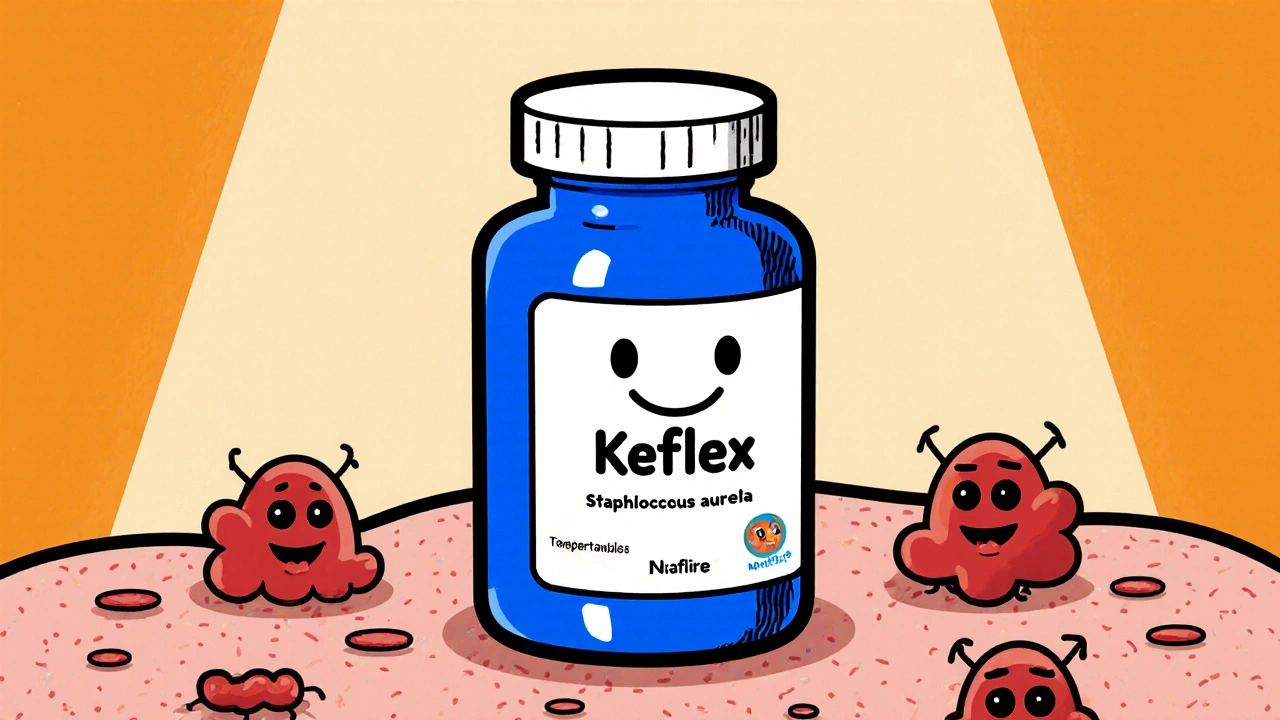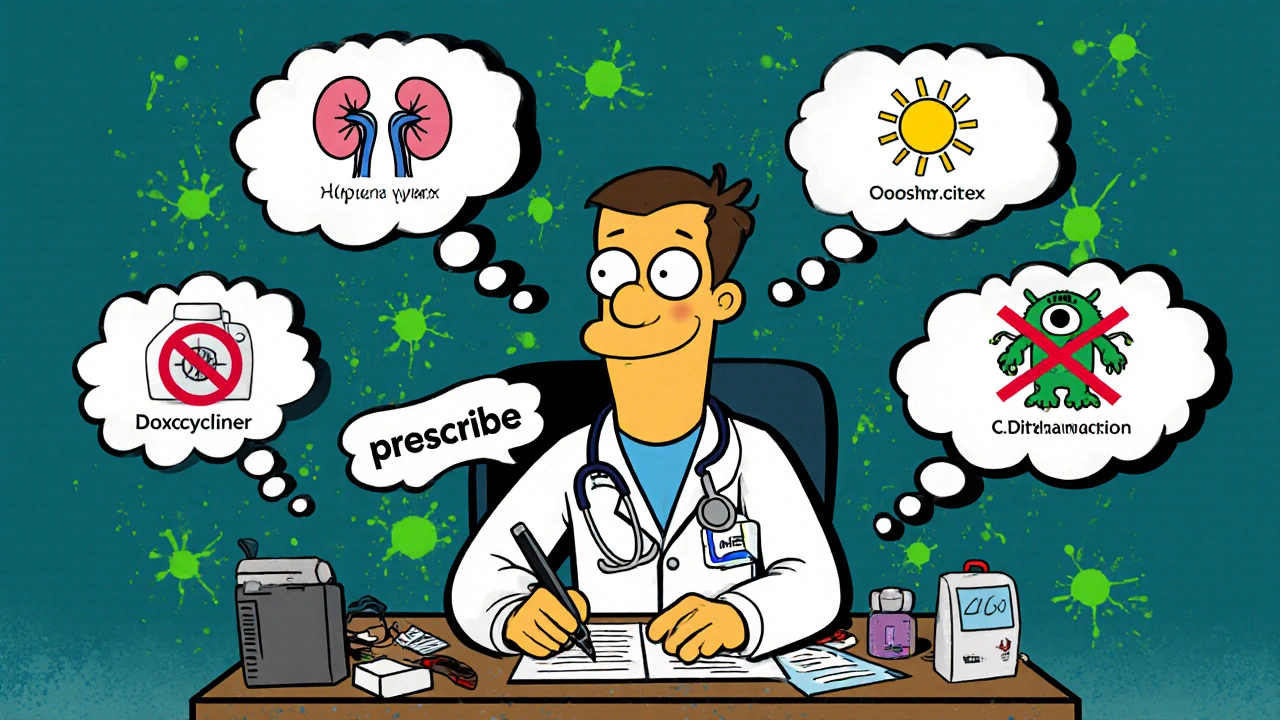 Oct, 21 2025
Oct, 21 2025
Antibiotic Selection Guide
Select Your Scenario
Results
Recommended Antibiotics
Key Considerations:
Important Safety Note: Always consult a healthcare professional before taking antibiotics. Complete the full course even if symptoms improve.
Select your scenario parameters to see antibiotic recommendations based on infection type, allergies, and patient factors.
When doctors need to tackle everyday bacterial infections, many reach for Keflex is a brand name for cephalexin, a first‑generation oral cephalosporin antibiotic. It’s cheap, widely available in Australia, and works well for skin, ear and urinary‑tract bugs. But it’s not the only option. This guide lines up keflex (cephalexin) against the most common alternatives so you can see when another drug might be a better fit.
Key Takeaways
- Keflex is a first‑generation cephalosporin effective against many gram‑positive bacteria.
- It’s taken orally, usually twice a day, and has a low risk of severe side effects.
- Alternatives such as amoxicillin, azithromycin and doxycycline cover different bacterial spectra and dosing conveniences.
- Resistance patterns, patient allergies and infection site dictate which drug is optimal.
- Always finish the full course, even if symptoms improve.
What is Keflex (Cephalexin)?
Cephalexin belongs to the cephalosporin class, which disrupts bacterial cell wall synthesis. In Australia, the usual adult dose is 250 mg to 1 g every 6-12 hours, depending on the infection severity. Because it’s excreted unchanged by the kidneys, dose adjustment is needed for renal impairment.
How Cephalexin Works
Like other β‑lactam antibiotics, cephalexin binds to penicillin‑binding proteins (PBPs) on the bacterial surface. This prevents the cross‑linking of peptidoglycan strands, leading to a weak cell wall that bursts under normal pressure. Its strongest activity is against gram‑positive cocci such as Staphylococcus aureus (non‑MRSA) and Streptococcus pyogenes.

Typical Alternatives
Amoxicillin is a broad‑spectrum penicillin that tackles many gram‑negative organisms in addition to gram‑positive ones. It’s often the first choice for otitis media, sinusitis and uncomplicated urinary infections.
Azithromycin is a macrolide with a long half‑life, allowing once‑daily dosing for up to five days. It covers atypical pathogens like Mycoplasma and Chlamydia, making it useful for respiratory infections.
Doxycycline is a tetracycline derivative that penetrates intracellular bacteria and is active against Lyme disease and certain acne‑related organisms.
Clindamycin is a lincosamide often reserved for anaerobic infections and skin‑structure infections when beta‑lactams cannot be used.
Trimethoprim‑sulfamethoxazole (Bactrim) combines two agents that block sequential steps in bacterial folate synthesis, useful for urinary‑tract and some respiratory infections.
Side‑by‑Side Comparison
| Antibiotic | Spectrum (Gram +/‑) | Typical Indications | Dosage Form | Common Side Effects | Resistance Concerns |
|---|---|---|---|---|---|
| Cephalexin (Keflex) | Gram + strong, limited Gram‑‑ | Skin, bone, urinary‑tract, ear infections | Capsules, oral suspension | GI upset, mild rash | Increasing ESBL‑producing Enterobacteriaceae |
| Amoxicillin | Broad (Gram + & ‑) | Sinusitis, otitis media, dental abscess | Capsules, suspension | Diarrhea, allergic rash | β‑lactamase producing H. influenzae |
| Azithromycin | Moderate Gram + & ‑ (incl. atypicals) | Respiratory, chlamydial, travel‑related diarrhea | Tablets, suspension | QT prolongation, GI upset | Macrolide‑resistant S. pneumoniae |
| Doxycycline | Broad, good intracellular | Lyme disease, acne, rickettsial fever | Capsules, tablets | Photosensitivity, esophagitis | Tet-resistant S. aureus |
| Clindamycin | Gram + and anaerobes | Severe skin, bone, anaerobic infections | Capsules, liquid | Clostridioides difficile infection | Inducible clindamycin resistance (iMLSB) |
| Trimethoprim‑sulfamethoxazole | Broad, especially urinary pathogens | UTI, Pneumocystis jirovecii prophylaxis | Tablets | Rash, hyperkalemia | Sulfonamide‑resistant E. coli |

How to Choose Between Cephalexin and Its Alternatives
Consider these factors before selecting a drug:
- Infection site and likely bacteria. Cephalexin shines for skin‑related gram‑positive bugs, while azithromycin covers atypical respiratory germs.
- Patient allergy profile. If the patient has a penicillin allergy, clindamycin or doxycycline may be safer than cephalexin.
- Renal or hepatic function. Cephalexin requires dose trimming in kidney disease; doxycycline is mostly liver‑cleared.
- Convenience. Azithromycin’s short, once‑daily regimen beats the twice‑daily dosing of many cephalosporins.
- Local resistance patterns. In Queensland, community‑acquired MRSA rates push clinicians toward clindamycin or trimethoprim‑sulfamethoxazole for skin infections.
When in doubt, culture and sensitivity testing gives the most reliable guidance. Empiric therapy should always be backed by the latest local antibiogram.
Frequently Asked Questions
Can I take Keflex if I’m allergic to penicillin?
Cephalexin belongs to the cephalosporin family, which shares a similar β‑lactam ring with penicillins. About 5‑10 % of penicillin‑allergic patients cross‑react, so a doctor may order an allergy test or choose a non‑β‑lactam like doxycycline.
What’s the typical adult dose of Keflex for a skin infection?
The usual regimen is 500 mg every 6 hours (or 250 mg every 6 hours for mild cases), taken for 7‑10 days depending on severity.
How does the safety profile of Cephalexin compare to Azithromycin?
Cephalexin’s side effects are mostly mild GI upset and rash. Azithromycin can cause QT‑interval prolongation and has a higher risk of drug‑interaction warnings, especially with heart medicines.
Is it okay to stop Keflex once I feel better?
No. Stopping early can let surviving bacteria regrow and develop resistance. Finish the full prescribed course even if symptoms subside.
Which alternative is best for a patient with a history of C. difficile infection?
Clindamycin carries the highest C. difficile risk, so it should be avoided. A safer choice would be amoxicillin (if no penicillin allergy) or a fluoroquinolone avoided for the same reason; trimethoprim‑sulfamethoxazole is often tolerated.
Choosing the right antibiotic is a balance of bacterial coverage, safety, patient factors and local resistance data. By comparing Keflex with these alternatives, you can work with your doctor to pick the drug that clears the infection fastest while minimizing side effects.

Sakib Shaikh
October 21, 2025 AT 00:52Alright folks, buckle up because I'm about to drop the ultimate cheat‑sheet on Keflex vs its rivals.
First off, cephalexin is cheap as chips in Aussie pharmacies and it hits gram‑positive skin bugs like a boss.
If you’ve got a renal hiccup, remember you gotta shave the dose – kidneys love it unaltered.
But don’t be fooled, the gram‑negative party is left at the door, so you might need amox or azithro for those sneaky bugs.
Bottom line: pick the drug that matches the bug, the patient’s allergies, and the local resistance map.
Ashok Kumar
October 26, 2025 AT 20:33Wow, thanks for the masterclass, but let's keep it real: most patients just need a simple two‑times‑daily script and a reminder to finish the bottle.
Side‑effects are usually just mild tummy grumbles, nothing that warrants a drama queen headline.
If you’re allergic to penicillins, a test is cheap and avoids the whole cross‑reactivity scare.
So yeah, stick to the basics and let the lab do the heavy lifting when you’re unsure.
Jasmina Redzepovic
November 1, 2025 AT 15:26From a pharmaco‑strategic standpoint, the discourse surrounding first‑generation cephalosporins often neglects the geopolitical implications of antimicrobial stewardship.
Australia's low‑cost generic cefalexin is laudable, yet its over‑reliance fuels ESBL proliferation, a vector that transcends borders and threatens global health security.
Clinicians must weigh the pharmacokinetic profile-renal excretion, beta‑lactam affinity-to the organism's resistome, especially in regions with endemic MRSA.
Therefore, integrating local antibiograms with patient‑centred pharmacodynamics is not merely best practice; it is a duty to prevent cross‑continental resistance spillover.
Esther Olabisi
November 7, 2025 AT 10:20Totally feel you on the resistance hype 🙄. But honestly, when you’re on the front lines, the easiest fix is just to pick the drug that won’t make you vomit for three days 😅.
So yeah, if you’ve got a patient who can’t tolerate the gut, maybe go for azithro – one‑daily vibes, no bathroom marathon.
And hey, if you’re worried about C. diff, just stay away from clindamycin like the plague – it’s basically a C. diff magnet 🚫.
Kimberly Lloyd
November 13, 2025 AT 05:13Choosing an antibiotic feels a bit like picking a travel companion – you want someone reliable, low‑maintenance, and suitable for the terrain ahead.
Cephalexin is a solid, predictable buddy for skin and bone, especially when the infection’s map is clear.
When the terrain gets rocky with atypical bugs, a more adventurous partner like azithromycin or doxycycline can make the journey smoother.
Ultimately, a thoughtful conversation with your clinician, armed with your personal health history, leads to the safest, most effective adventure.
Lolita Gaela
November 19, 2025 AT 00:06The pharmacodynamic parameters governing β‑lactam efficacy, namely %T>MIC, underscore the necessity of maintaining serum concentrations above the minimal inhibitory concentration for a sufficient duration.
Cephalexin’s dosing regimen of q6‑12h ensures adequate %T>MIC for gram‑positive cocci, whereas macrolides achieve peak concentrations that compensate for a longer half‑life.
In practice, aligning the drug’s PK/PD profile with pathogen susceptibility data optimizes clinical outcomes while mitigating collateral damage to the microbiome.
Giusto Madison
November 24, 2025 AT 19:00Let’s unpack the decision matrix for prescribing Keflex versus its alternatives, step by step, because the stakes are higher than a simple pill choice.
First, identify the infection site – skin and soft tissue infections are dominated by Staphylococcus aureus (non‑MRSA) and Streptococcus pyogenes, which are exquisitely sensitive to first‑generation cephalosporins, making Cefalexin a cost‑effective front‑liner.
Second, evaluate patient comorbidities – renal insufficiency mandates dose reduction since Cefalexin is excreted unchanged; contrast that with Doxycycline, which is hepatically cleared and thus safer in renal compromise.
Third, assess allergy history – while only 5‑10 % of penicillin‑allergic patients cross‑react with cephalosporins, a documented IgE‑mediated reaction may tip the scales toward a non‑β‑lactam such as Clindamycin or a tetracycline class.
Fourth, consider local resistance patterns – in Queensland, rising ESBL‑producing Enterobacteriaceae diminish Cefalexin’s utility for urinary tract infections, prompting a shift to Trimethoprim‑Sulfamethoxazole or a fluoroquinolone, albeit with caution regarding tendinopathy.
Fifth, weigh dosing convenience – Azithromycin’s once‑daily dosage for five days improves adherence compared to Cefalexin’s twice‑daily schedule, which can be a barrier for busy patients.
Sixth, factor in side‑effect profiles – Cefalexin’s gastrointestinal upset is generally mild, whereas Clindamycin carries a high risk of C. diff infection, and Macrolides can prolong the QT interval, a concern for patients on cardiac meds.
Seventh, scrutinize drug‑drug interactions – Azithromycin’s CYP450 inhibition may clash with statins, whereas Cefalexin has a relatively clean interaction slate.
Eighth, reflect on cost and accessibility – in Australia, generic Cefalexin is inexpensive and widely stocked, whereas newer agents may be limited to specialist pharmacies.
Ninth, prioritize culture and sensitivity results whenever feasible; empirical therapy should be a bridge, not a long‑term solution.
Tenth, educate the patient on the importance of completing the full course; early cessation fuels resistant subpopulations, undermining future treatment efficacy.
Eleventh, document the rationale in the medical record – this transparency aids future clinicians in stewardship efforts.
Twelfth, schedule follow‑up to assess clinical response and adjust therapy if needed.
Thirteenth, consider adjunctive measures such as wound care or hydration, which can synergize with antimicrobial therapy.
Fourteenth, stay updated on regional antibiograms; resistance trends evolve, and yesterday’s best choice may be tomorrow’s suboptimal one.
Finally, remember that the ultimate goal is to eradicate the pathogen while preserving the patient’s microbiome and minimizing collateral damage – a balance that only thoughtful, evidence‑based prescribing can achieve.
erica fenty
November 30, 2025 AT 13:53Great roadmap – every clinician needs this playbook for smart antibiotic stewardship!